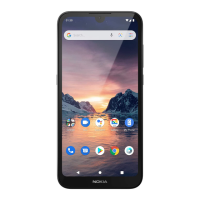
Do you have a question about the Nokia 1.3 and is the answer not in the manual?
| Subscription type | No subscription |
|---|---|
| USB version | 2.0 |
| USB connector type | Micro-USB |
| Headphone connectivity | 3.5 mm |
| Headset included | Yes |
| 4G standard | LTE |
| 3G standards | WCDMA |
| SIM card type | NanoSIM |
| Wi-Fi standards | 802.11b, 802.11g, Wi-Fi 4 (802.11n) |
| Bluetooth version | 4.2 |
| SIM card capability | Dual SIM |
| Mobile network generation | 4G |
| Flash type | LED |
| Front camera type | Single camera |
| Video capture resolution (max) | - pixels |
| Rear camera resolution (numeric) | 8 MP |
| Front camera resolution (numeric) | 5 MP |
| Battery capacity | 3000 mAh |
| Standby time (3G) | - h |
| Battery technology | - |
| Platform | Android |
| App distribution platform | Google Play |
| Operating system installed | Android 10.0 |
| Wireless charging | No |
| RAM capacity | 1 GB |
| Compatible memory cards | MicroSD (TransFlash) |
| Maximum memory card size | 400 GB |
| Internal storage capacity | 16 GB |
| Processor family | Qualcomm |
| Coprocessor cores | 4 |
| Processor frequency | - GHz |
| Coprocessor architecture | ARM Cortex-A53 |
| Screen shape | Flat |
| Display diagonal | 5.71 \ |
| Native aspect ratio | 19:9 |
| Form factor | Bar |
| Product color | Cyan |
| Depth | 9.35 mm |
|---|---|
| Width | 71.2 mm |
| Height | 147.3 mm |
| Weight | 155 g |
Learn to update your phone software for new features and performance improvements.
Identify the main physical components and connectors of your phone.
Instructions on how to insert nano-SIM and microSD cards into the phone.
Guide on connecting the charger and powering up the device's battery.
Steps to power on the phone and complete initial setup.
Information on using two SIM cards for different purposes.
Methods to secure your phone's screen and keys.
Basic gestures and operations for interacting with the touch screen.
Customize wallpaper, ringtone, and notification sounds on your device.
How to use and manage the notification panel and app notifications.
Adjusting the phone's volume for calls, media, and alarms.
Using keyboard suggestions and correcting misspelled words for efficient typing.
Accessing and using Google Assistant for various tasks via a dedicated key.
Tips and settings to extend the phone's battery life and conserve power.
Adjusting font size and display size for easier phone usage.
Instructions for listening to the radio using a connected headset.
Making and answering phone calls, including call history.
Saving, managing, and adding contacts to your phone.
Composing and sending text messages to recipients.
Setting up and sending emails using the Gmail app.
Taking photos, focusing, and using camera features like HDR.
Recording and stopping video clips using the camera app.
Viewing photos and videos stored on your phone and copying them.
Steps to turn on and connect to Wi-Fi networks for internet access.
Using the Chrome browser to access websites and search the web.
Connecting wirelessly to other devices using Bluetooth for sharing and communication.
Setting up and using a secure Virtual Private Network connection.
Setting the date, time, and clock format, and updating them automatically.
Setting, modifying, and switching alarms on and off.
Managing calendars, adding events, and setting reminders for appointments.
Using Maps Go to find locations and get driving or walking directions.
Downloading and installing applications from the Google Play Store.
Moving files to a memory card or deleting unnecessary files to free up storage.
Moving photos, documents, and files to a microSD card.
Checking for and installing system software and app updates.
Enabling automatic backup for device data and app settings.
Resetting the phone to factory settings and erasing all personal data.
Setting up authentication methods like PIN, pattern, or password for screen lock.
Configuring face unlock feature for convenient and secure phone access.
Modifying the default SIM Personal Identification Number for enhanced security.
Understanding PIN, PIN2, PUK, PUK2, and lock codes for SIM and phone security.
Essential safety guidelines for using the device responsibly and avoiding hazards.
Information on when and where to switch off the device to prevent interference or danger.
Emphasis on obeying traffic laws and prioritizing safety while driving.
Awareness of potential interference issues with wireless devices.
Guidance on using only authorized personnel for product installation and repair.
Using only approved batteries, chargers, and accessories with the device.
Precautions to maintain the device's dryness and protect it from moisture.
Information about the glass components and handling precautions for breakage.
Advice on preventing hearing damage from prolonged high volume usage.
Information on Specific Absorption Rate (SAR) and RF exposure guidelines.
Understanding network dependencies and potential costs for using services.
Procedures for making emergency calls and important considerations.
General tips for handling and maintaining the device, battery, and charger.
Guidance on proper recycling of electronic devices and batteries.
Explanation of the symbol indicating proper disposal of electronic waste.
Details on battery types, charging, and replacement.
Safety precautions for charging and using the battery and charger.
Warning about small parts in the device and keeping it away from children.
Potential interference between wireless devices and medical equipment.
Recommendations for safe use around implanted medical devices.
Warning about headset use affecting awareness of surroundings and potential hearing aid interference.
Precautions against viruses, malicious software, and untrusted sources.
Information on radio signal effects on vehicle electronic systems and installation.
Safety instructions for operating the device in potentially explosive areas.
Details on RF exposure limits and compliance with SAR guidelines.
Information on respecting copyright and legal rights when using content.
Disclaimers, warranty information, and terms of use for the device and software.